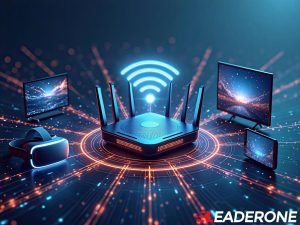
Digital illustration of Wi-Fi 8 delivering ultra-high-speed data transmission for immersive XR, 4K/8K streaming, and cloud computing, representing the future of high-capacity wireless networking.
Wireless technology is always changing. Our world demands faster, more reliable connections. This drives innovation. Two technologies will shape a new wireless connectivity blueprint: Wi-Fi 8 and UWB Radar. Both are still evolving. Yet, recent talks and tech advances show how they will redefine our digital lives.
The Road Ahead: Wi-Fi 8 is Emerging
Wi-Fi keeps getting faster and more efficient. Wi-Fi 7 (802.11be) is now common. The industry already looks to its successor: Wi-Fi 8. The final standard (802.11bn) is years away. It’s likely not before the mid-2030s. Still, its conceptual groundwork is forming.
Key focus areas for Wi-Fi 8 include:
- Even Higher Throughput: Wi-Fi 8 aims for much faster data rates. It could reach hundreds of gigabits per second. This supports immersive XR (Extended Reality) and ultra-high-definition streaming. Cloud computing will be instantaneous.
- Enhanced Reliability and Latency: This is vital for industrial IoT and autonomous systems. Wi-Fi 8 will use advanced methods. It ensures ultra-low latency and consistent performance.
- AI/ML Integration: Future Wi-Fi might use AI and machine learning. This means smarter spectrum management. It allows adaptive beamforming and predictive congestion control. Performance will be optimized dynamically.
- Sustainability: Energy efficiency remains key. This extends battery life for devices. It also reduces the environmental footprint of networks.
Wi-Fi 8’s evolution means providing robust, high-capacity wireless local area networking. This is for an increasingly data-hungry world.
Beyond Connectivity: UWB Radar’s Power
Wi-Fi handles data. UWB (Ultra-Wideband) Radar offers precise sensing. It provides accurate ranging. UWB uses very short pulses across a wide spectrum. This helps it determine distance and position. It can even detect small movements through walls. Recent developments expand its uses beyond basic ranging.
Updates on UWB Radar often show its growing versatility:
- Enhanced Sensing Capabilities: UWB radar is better at detecting vital signs. It senses breathing and heartbeats. It also performs presence detection for security or smart homes. Gesture recognition is possible for human-machine interfaces. This moves beyond just “where” to “what” is happening.
- Automotive Integration: UWB is now in vehicles. It allows secure keyless entry and accurate parking. It also helps with advanced cabin monitoring. This can detect children or pets left behind. UWB radar boosts traditional radar for short-range sensing.
- Industrial and Logistics Applications: UWB radar offers great accuracy and reliability here. It helps with precise asset tracking. It aids collision avoidance in factories. It even guides drones in complex areas.
- Low Power Consumption: It works well with very low power. This makes it ideal for battery-powered IoT devices and wearables.
UWB radar gives highly detailed spatial awareness. This makes it crucial for future smart environments and autonomous systems.
Forging the New Wireless Blueprint
Individually, Wi-Fi 8 and UWB Radar are big steps forward. Together, they form parts of a larger new wireless connectivity blueprint. Wi-Fi 8 will handle high-speed data. UWB Radar will provide precise spatial awareness. Imagine a smart home. Wi-Fi 8 powers all streaming. UWB radar monitors occupancy for energy efficiency. It also senses gestures for device control. Or a factory. Wi-Fi 8 connects machinery. UWB radar ensures worker safety.
This evolving blueprint promises a future. Wireless connectivity will be smart and aware. It will integrate seamlessly into our lives. This vision’s journey is ongoing. Constant innovations will shape what comes next.
